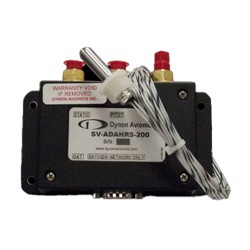ADAHRS stands for Air Data/Attitude/Heading Reference System. The SkyView ADAHRS module uses MEMS sensor technology to accurately measure inertial, magnetic, and air data. These provide the data necessary to drive the Artificial Horizon/Synthetic Vision, Airspeed, Altitude, Vertical Speed, Slip, Turn Rate, Angle of Attack, and Gyro-Stabilized Heading. Additionally, Outside Air Temperature is obtained from the SV-OAT-340 Sensor which is connected to the ADHARS Module.
Dynon sells a primary ADAHRS model (SV-ADAHRS-200) and a backup model (SV-ADAHRS-201). The primary and backup models are identical in functionality, however you must have at least one SV-ADAHRS-200 in the system in order for the SV-ADAHRS-201 to function.
A SV-OAT-340 Outside Air Temperature Sensor is included with each AV-ADAHRS-200/201.
You may have one, two, or more ADAHRS in your SkyView System. If one fails, the backup ADHARS will provide data to the SkyView Display(s). To maintain complete redundancy, a separate SV-OAT-340 Sensor should be connected to each ADAHRS. Note that functionally, the SV-ADAHRS-200 and the SV-ADAHRS-201 are the same. The only difference is that the SV-ADAHRS-201 requires an SV-ADAHRS-200 in the same system in order to be activated. In the event that the SV-ADAHRS-200 is removed from the system, the SV-ADAHRS-201 will remain activated for an additional 30 flight hours before it becomes deactivated.
A SkyView Network Cable is used to connect an ADAHRS Module to a Display. One ADAHRS will provide data to as many Displays as are connected in the SkyView System. However, for redundancy, you may want to provide one ADAHRS for each Display.
An ADAHRS requires an outside reference in order to quickly find and maintain its reference horizon. Dynon ADAHRSs use air speed derived from the pitot and static ports as their primary outside reference. Airspeed is the best reference to enable a fast attitude capture; Dynon units can typically find the horizon in under 10 seconds, even in flight. Units that do not use air speed can often take several minutes to find the horizon, and often require straight and level flight or to be stationary on the ground. In order to have a backup in the unlikely event of loss of pitot or static data, all Dynon ADAHRS revert to GPS ground track if a GPS is connected.
The ADAHRS internal sensors measure rotational motion and acceleration about the CG of the aircraft. In order to be maintain accuracy, the ADAHRS should be mounted within six feet laterally (side-to-side) and twelve feet longitudinally (front-to-back) of the aircraft CG. Quite often the best place to mount the ADAHRS is in the fuselage behind the cockpit area. But other locations can work.
The ADAHRS Modules include a Magnetometer (Remote Compass). This means that it needs to be located in magnetically benign location, away from high current wires and moving aircraft components that contain a ferrous material.
An ADAHRS installation location should be a rigid surface within 12 feet longitudinally and 6 feet laterally of the aircraft's center-of-gravity.
- You may have one, two, or more ADAHRS in your SkyView System. If one fails, the backup ADHARS will provide data to the SkyView Display(s).
- Provides the data necessary to drive the Artificial Horizon/Synthetic Vision, Airspeed, Altitude, Vertical Speed, Slip, Turn Rate, Angle of Attack, and Gyro-Stabilized Heading. Additionally, Outside Air Temperature is obtained from the SV-OAT-340 Sensor which is connected to the ADHARS Module.
- Dimensions: 4.71"W x 1.22"H x 2.61"D
- Weight: 8.2 oz.
- SV-ADAHRS-200
- SV-OAT-340
- 3 - Pneumatic ports for Pitot, Static, and Angle of Attack
- 1 - 9-Pin DIN Connector for the SkyView Network
- 2 - 2-Pin Connector for SV-OAT-340 Sensor




